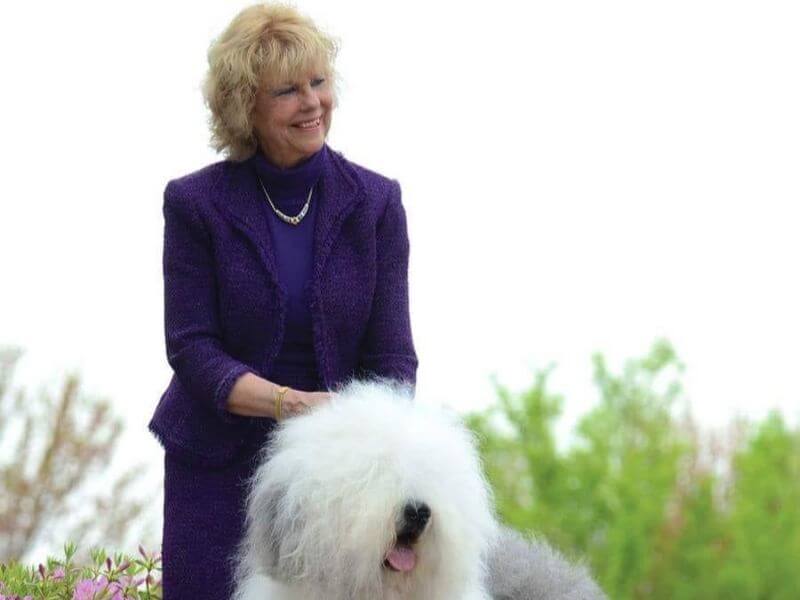Interview with Jere Marder, Breeder of Lambluv Old English Sheepdogs
Please tell us a little bit about yourself. Where do you live? What is your breed? What is your kennel name? Do you have a website? How long have you been in dogs? How long have you been breeding dogs? Who are some of your best-known dogs?
My name is Jere Marder and I’m a breeder/owner-handler of Old English Sheepdogs. For 40-plus years, I’ve bred under the “Lambluv” prefix, a dear pet name given to me by my Husband, Michael. The name carried a lot of love, and thus, was fitting to use for the puppies we’ve produced. We got our first sheepdog, “Bridgette,” on Christmas 1969 while we were living in Chicago. For many years, my routine was walking our dogs up and down flights of stairs for their daily walks around Chicago. It was years later that we relocated to our name home in Valparaiso, Indiana.
I did operate a website, http://www.lambluv.com, and still have one active, but the regime of campaigning dogs kept me busy for many years. I was blessed with a good foundation in sheepdogs, and thus, have had a number of successful dogs over the years, with more than 15 to earn Best in Show. The dog always at the front of my memory is “Yoshi,” CH Lambluv’s Desert Dancer. Yoshi had an amazing campaign, including the recipient of the Quaker Oat’s Award. Other influential dogs I had were “Bette,” CH Lambluv’s The Devine Miss M, winner of the Centennial Specialty, and “Elvis,” GCHP Lambluv Gambolon Blue Thunder, my first platinum grand champion Old English.
As a Breeder, can you share your thoughts on your breed today? Is breed type strong? Are there things to be concerned about? Are there any health-related issues? Have you worked with breeders overseas? Are pet homes typically available for your breed?
From a breeder’s perspective, the spectrum of quality has swung in both directions over the years as a result of changes in styles and fads shown in the ring. Overall, I’ve noticed a decrease in balanced specimens; dogs lacking reach or over-extending in the rear, and sheepdogs that are rectangular or reverse rectangle instead of square. These examples are issues that have always been present in the breed, but over the years they have become more prevalent.
Over the years, I’ve had some wonderful, loyal families reach out who were interested in pursuing the dedication of owning an Old English. These have been some of the best homes for my dogs. I’ve been fortunate with the opportunity to work with several breeders from across the world; Colm Hastings of Ireland, Nikolas Kanales of Greece, and Naoya & Ryoko Fukuda of Japan, to name a few.
As an Exhibitor, can you comment on recent entries in your breed? Are majors available in your area? Does your breed often participate in Companion and Performance events? How can newcomers in your breed be encouraged to join the sport of dogs?
As the years have gone by, our breed has slowly become a low-entry breed. Gone are the glory days, when Old English entries were well over 100 at the large shows and/or specialties. That being said, majors are still available in areas around the country. We live in an age of technology where exhibitors may even work together to ensure good entries at shows so that points (majors) are present.
There are many Old English that have participated successfully in performance venues. These dogs are eager to work and be with humans, a combination that is ideal to the events beyond the Conformation ring. Encouraging those interested, to TRY, is the best advise! No individual starts at the top of any field—it’s a journey that begins with one step. Finding a mentor along the way is a great source of guidance and support for an individual who is new to (coated) dogs.
What are the biggest challenges facing the dog show community as a whole and how can we address them? And finally, what are some of the positive changes you’ve seen in your breed and in the dog show community as a whole over the past decade?
As costs (entries, travel, etc.) to exhibit increase, it becomes more difficult for some in the sport to go as readily as once done in the past. This barrier can also dishearten newcomers, as the price to travel weekends to shows outweighs their budget. For the coated breeds exhibited, it could also be said that there is a decrease in interest in dedicating the time necessary to groom the dogs for show. Old English are no exception. The best we can do as breeders and mentors is to nurture the interest of those who approach us and be supportive in shepherding their education in the breed. There are no shortcuts for dog shows, but for those who want to learn and grow, we as mentors should be there every step of the way.








